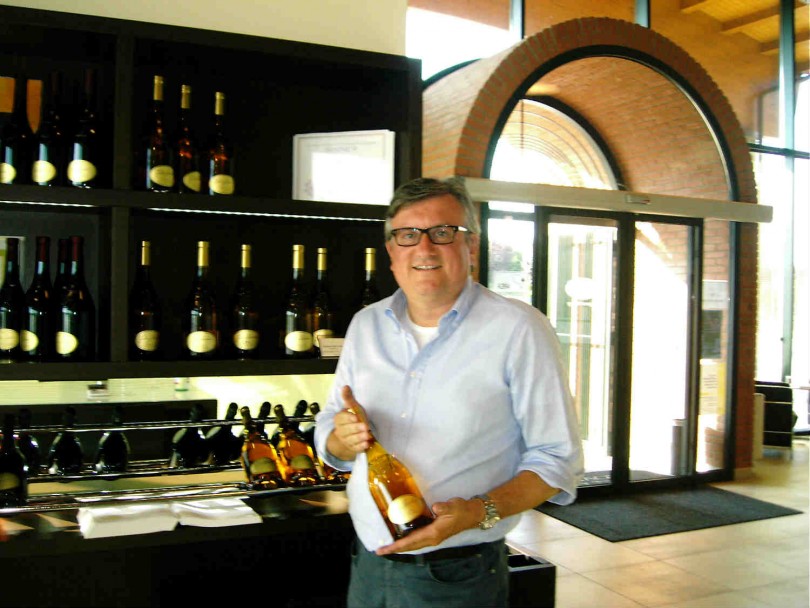Organic fever looks set to spread alto in the Lugana area: one of the first wineries to firmly believe in this new opportunity is Ca Maiol, one of the “giants” on the Garda wine scene Garda with a production of 1.8 million bottles in which are also included wines of the Valtènesi Doc. In 2016 the celebrated Lugana Molin, who in the 2014 version was the only Lombardy white wine to be awarded the prestigious Tre Bicchieri by the Gambero Rosso guide, will reach the market alto in an organic version. For the moment only a part of the production of the 2015 harvest will be sold as certified organic, namely that relating to the 14 hectares that have concluded the three-year period of conversion to the new cropping system required by the law: the project however covers 44 hectares and will end in 2017, when the entire production of Molin will arrive on the market with the label of organic certification.
“We are very pleased with the first results – says Fabio Contato, leader of the Desenzano del Garda winery -. With the organic methodology we got a product undoubtedly more outspoken and typical, more connected to the matrix of the grape. Like, a Lugana closer to his more traditional vocation”.
This is only one of the main innovations of a very intensive 2015 for Ca Maiol, which has faced a particularly hard challenging as the name change, definitively abandoning the old Provenza name.
“It was not easy to abandon a brand with which we were known since 1960 – says Fabio -. It took an act of courage but this choice was made because this reference to France in our old name (Provenza means Provence) was likely to be a confounding factor. We then decided to go in the opposite direction, strengthening the brand in connection with the original name of the area where our company was born: ie the Cascina Maiol erected in 1710 by Sebastiano Maioli, a Desenzano lawman, which is still the heart of our company today. ”
Maioli, apparently, was a big fan of viticulture, as revealed by excavations on the land where grape roots were found three times to show that this was also a place dedicated to the ancient wine production.
“In the end the change has done us well and has strengthened our image – says Fabio -. We relocated the right way in our geographical area, and the market has proved us right: we will close this year with a growth of 25%. ”
Ca Maiol wines are highly appreciated abroad: 55% of the production takes the path of foreign markets, with Germany the first historical account along with new countries like Australia and Russia. Lugana is obviously the primary reference, available in three basic labels like Prestige, the aforementioned Molin, and the Fabio Contato Reserve, plus a Metodo Classico available in two versions, 36 that 60 months. And then there are the labels of Doc Valtènesi: Chiaretto, Groppello, and the Fabio Contato Rosso, which is currently still a Garda Classico (Gold Medal at the Brussels Concours with the 2009 vintage) but will become a Valtènesi with vintage 2011. “I really believe in this Doc, which represents a great opportunity for the Garda area – says Contato -. For us, after this latest conversion to the name, the Valtènesi will have an important weight, equal to about 300,000 bottles. ”
Organic is obviously a challenging step. “We chose to look with new attention to the consumer to provide healthier products. But we do not stop there; ours is a wider green path in terms of management, which goes from the reduction of about 40% of energy used in the adoption of LED lighting to the decision to heat the rooms with pellets produced in our fields in 2016. These are choices in which we deeply believe. ”
The bottle
The flagship of the vast Ca Maio is undoubtedly the Lugana Reserve Fabio Contato. “It ‘s a wine that I particularly love – explains Fabio- obviously not only because it bears my name, but also because it has led to great recognition and appreciation in the domestic market but also in countries such as Switzerland and Japan.”
At the base of this reserve there is a rigorous manual selection of the best grapes from the oldest vineyards of the company, carried out by 10 people chosen and trusted personally by Fabio, which proceed to the selection based on criteria ranging from the shape of the cluster to the consistency of the grain. The harvest takes place in late September, when the grapes are already in an advanced stage of maturity: the initial winemaking is in steel, then it all goes in new Frenche barriques and there remains for eight months. Everything is then put together in steel barrels for 6 months, and a further six in bottle before coming on the market. The final results are a confirmation of the great qualities of longevity typical of Lugana: supported by wood tannins, this is a wine with a long life perspective, and one which finds its most complete expression in combining in dishes truffles, foie gras or white meats in saucepan.


Leave a Comment